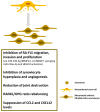Mesenchymal Stem Cell-Derived Secretome: A Potential Therapeutic Option for Autoimmune and Immune-Mediated Inflammatory Diseases
- PMID: 35892597
- PMCID: PMC9367576
- DOI: 10.3390/cells11152300
Mesenchymal Stem Cell-Derived Secretome: A Potential Therapeutic Option for Autoimmune and Immune-Mediated Inflammatory Diseases
Abstract
Immune-mediated inflammatory diseases (IMIDs) encompass several entities such as "classic" autoimmune disorders or immune-mediated diseases with autoinflammatory characteristics. Adult stem cells including mesenchymal stem cells (MSCs) are by far the most commonly used type in clinical practice. However, due to the possible side effects of MSC-based treatments, there is an increase in interest in the MSC-secretome (containing large extracellular vesicles, microvesicles, and exosomes) as an alternative therapeutic option in IMIDs. A wide spectrum of MSC-secretome-related biological activities has been proven thus far including anti-inflammatory, anti-apoptotic, and immunomodulatory properties. In comparison with MSCs, the secretome is less immunogenic but exerts similar biological actions, so it can be considered as an ideal cell-free therapeutic alternative. Additionally, since the composition of the MSC-secretome can be engineered, for a future perspective, it could also be viewed as part of a potential delivery system within nanomedicine, allowing us to specifically target dysfunctional cells or tissues. Although many encouraging results from pre-clinical studies have recently been obtained that strongly support the application of the MSC-secretome in IMIDs, human studies with MSC-secretome administration are still in their infancy. This article reviews the immunomodulatory effects of the MSC-secretome in IMIDs and provides insight into the interpretation of its beneficial biological actions.
Keywords: autoimmune diseases; exosomes; extracellular vesicles; immune-mediated inflammatory diseases; mesenchymal stem cell-derived secretome.
Conflict of interest statement
The authors declare no conflict of interest.
Figures





References
-
- Shah A.A., Khan F.A. Types and Classification of Stem Cells. In: Khan F.A., editor. Advances in Application of Stem Cells: From Bench to Clinics. 1st ed. Humana Press; Totowa, NJ, USA: 2021. pp. 25–49.
Publication types
MeSH terms
LinkOut - more resources
Full Text Sources

